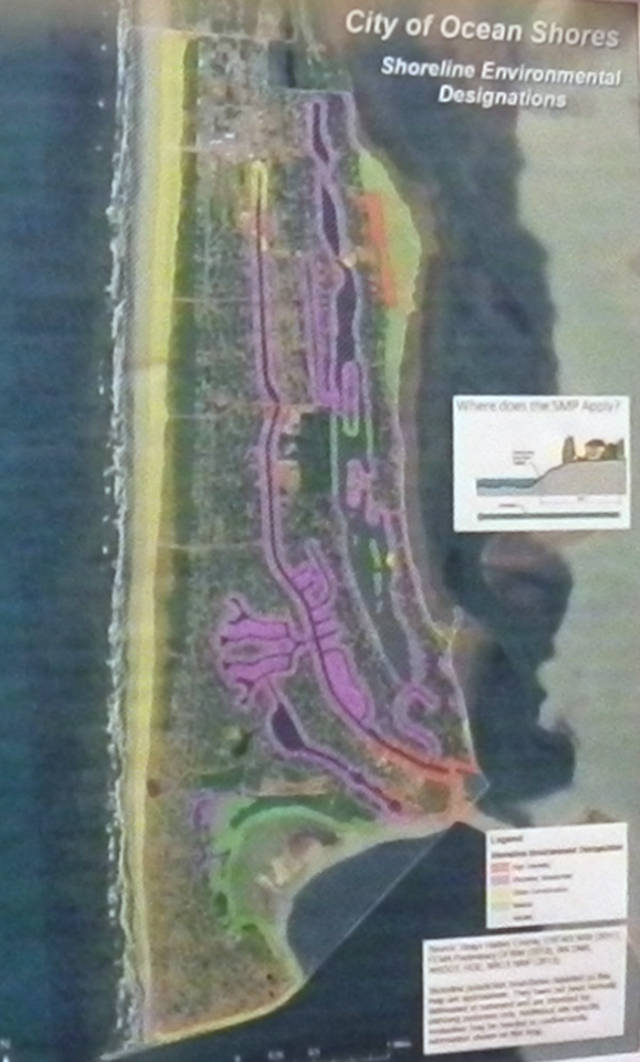The Ocean Shoes City Council was called into session for a special meeting on Tuesday to approve an ongoing moratorium on development in an area near the North Jetty where the shoreline has been eroding during past winter storms.
Mayor Crystal Dingler explained the special meeting was needed because the existing moratorium was set to expire before the city fully adopts a new Shoreline Management Program (SMP) update with more stringent regulations on shoreline development and uses city-wide.
The updated Shoreline Master Program will replace the city’s existing shoreline regulations, last amended in 1991, and will guide development and activities along all the estimated 70 miles of shoreline within city limits, including the Pacific Ocean, Grays Harbor, Duck Lake, Minard Lake and the canals.
After a lengthy review process led by the city’s Planning Commission and the forwarded to the state, the updated plan for Ocean Shores was given conditional approved by the state Department of Ecology earlier this month, with a five pages of modifications and suggestions.
Once the SMP process is complete, “then the moratorium will go away and the new rules” will govern the proper setbacks and guidelines for development in that area, the mayor noted.
The legal description of the property impacted by the moratorium is Block 1, Division 19 and 19a. The moratorium first was enacted by the City Council in February 2016, then renewed three successive times, with the last one for six months on Jan. 8, 2018. The new action would extend the moratorium another six months “until the city completes the process of of analysis and studies relating beach erosion for the areas subject to this moratorium.”
The moratorium is on the acceptance of applications for “living space, new living space development or redevelopment for properties” in that division just north of the jetty.
“We suddenly realized the moratorium would expire” on Aug. 22 if no action was taken by the city, Dingler said. “We’re getting much closer on the Shoreline Master Plan.” Before the final document is complete, however, the City Council will hold a study session on the changes suggested by the state.
“They have given their final comments, and the Planning Commission has reviewed those and accepts them, so we just have to come to Council” and adopt the policies as city code, Dingler said.
The proposed program prioritizes water-oriented uses and development within the city’s shoreline areas; identifies potential restoration projects for future efforts in a restoration plan; and, incorporates critical area regulations to protect sensitive areas within shoreline jurisdiction.
The general policies and regulations of the SMP pertain to all development, uses and activities in shoreline environments, with the stated intent being: (A) Protect environmental resources. (B) Reduce the likelihood of harm to life or property from hazardous conditions. (C) Promote access to shorelines.
Some of the state’s comments on the city’s document included support for both a dune management program to “address the serious fire hazard in the area adjacent to the city’s hotels,” and a comprehensive vegetation management program along the freshwater lakes and canals.” Changes and clarifications, however, were requested to the procedure for calculating common line buffers and setback regulations, and State Parks had concerns about a section allowing the city to sell sand off the beaches.
“All application for sand removal must first be approved by State Park. Removal is also subject to review from other environmental regulatory agencies.”
The policies give preference to uses that:
•Encourage water‐dependent uses that “are consistent with control of pollution and prevention of damage to the natural environment.”
• Protect shoreline natural resources.
• Promote public access and consider the “overall best interest of the state and people generally.”



